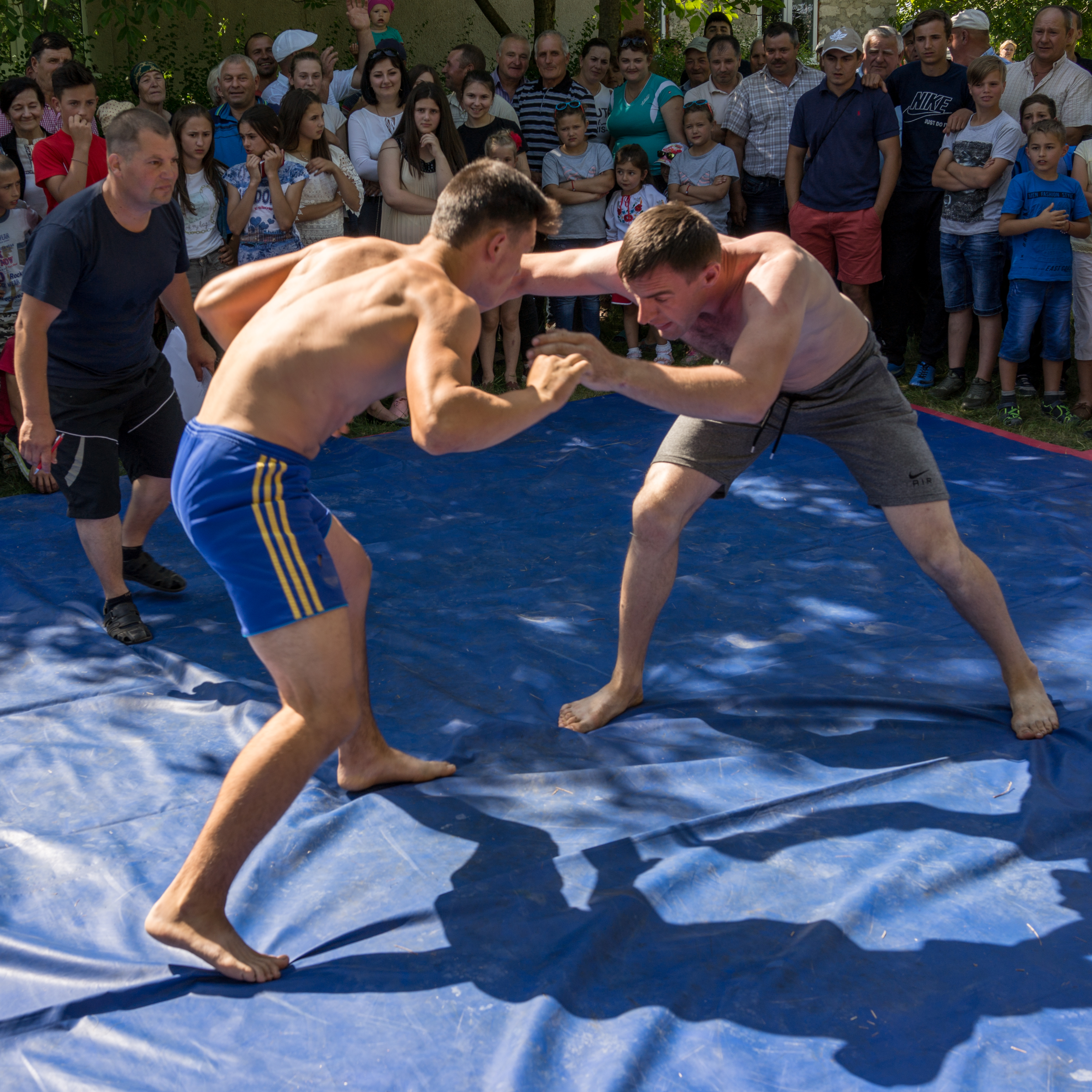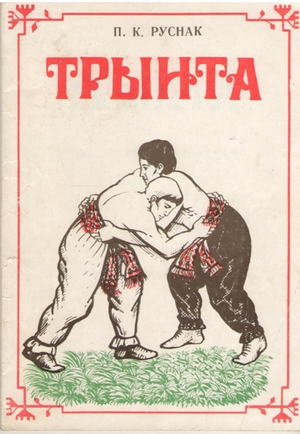
Tranta (Moldova, Romania)
- Name of sport (game): Tranta, Trynta
- Name in native language: Trânta, Трынта
- Place of practice (continent, state, nation):
Moldova, Romania (Transylvania)
- History:
The historical and literary source denote the appearance of this fight "wrestle" at the end of the 14th - the beginning of the 15th centuries named squabble, being a means of physical training of the soldiers. The Moldavian fight was described for the first time in the ballads "Radu Calomfirescu" and "Mihu the Child" by the poet Vasile Alecsandri (1821-1890), while gathering folk creations of the 14-15 centuries. In the ballad "Radu Calomfirescu" it's visible that the squabble was also a heroic game, like those known under the French name "tournoi". In another ballad, distinctive elements of the fight between the Romanian Mihu and the Hungarian Ianus are described: a fight in all the chivalrous rules. First of all, both the fighters were sitting at the table, having some drink and then they began the fight, which did not start without audience. That is the fight, as the author said, took place on the ground, with application of different methods like twisting, hitting, throwing, casting to the ground. In Mihail Sadoveanu's novel "Nicoara Potcoava" the time of Stefan cel Mare is described, and the author reflects the traditions according to which the strongest heroes were chosen in the belligerent force and their fight was to decide the battle's result, for the whole army not to be exterminated. The fight victor was winning the war. In another novel by Mihal Sadoveanu " The brothers Jderi", one of the favorite proceeding of the national fight is shown. Thus, Ionel Par-Negru (black hair) defeated the Turk Uzun-Slondimb through shepherd's method: he went down on his back and threw the opponent over head, supporting him with a leg on his stomach, as out of a catapult. On holidays, the lads were assembling and beginning daring games. At the beginning of the fight they were grasping each other at waist in crossed motions applying various fight methods: lifting each other, dropping each other on the tendons, acting with legs, jumping. Bogdan Perticeicu Hasdeu in "Ion Voda cel Cumplit" wrote that the Moldavians liked target shooting and in this art only English archers were worth of them, but they preferred more the hand-to-hand fight. "The Ruler of Moldova has 30000 soldiers, 15000, the most brave among them possess the fight." The fighters were applying such methods as trips, jerking, shepherd's method (throwing over the head). The fight was taking place directly on the ground, in the presence of the audience, being escorted by a musical accompaniment; rude and harsh methods were not applied. The competitions were taking place with the occasion of popular and familiar holidays. They were beginning spontaneously as a wish to measure the strength and the skillfulness.
The Moldavian national fight appeared centuries ago in the nation labor activity process and was developed independently in various original forms, being both a means of the physical growth of the youth and of the training of the armed forces. The historical and literary archive informations helped at solving disputable problems as concerns the wrestle variants, certain technical proceedings, tactics, instruction methods, training for competitions, rules and conditions of the competition organization.
The analysis proves that two variants of the national fight existed at the Moldavians: with and without trips. The fight without trips was practiced in the north part of Moldova, but in the central and southern the trip was allowed as well as legs throwing over legs, over thigh. Although an organized instruction was in missing the fight rules and the skill were handed down from one generation to another in each village of Moldova.
In 1954 a group of young enthusiastic coaches set to themselves the goal to resurrect every sport. In the period of 1954 -1970 many skillful sportsmen appeared. All of them began their way in sport from the place when they were solving childish quarrels by means of wrestle. Among those are the ex-champions, multiple winners at different World competitions at sambo and judo - Valentin Gutu, Gheorghe Cotic, Constantin Bas; the country championship winners - the brothers Ion and Semion Curdov, Vasile Luca, Nicolae Goria; a whole pleiad of the Masters in Sport - the first Moldavian Champion at wrestle - Ghenadii Badanov, multiple victors and winners at Republican Championship, Ivan Dobrovolski, Dmitrii Tiron, Dmitrii Boieru, Nicolae Lutcanov, Petru Rusnac, as well as honored republican coaches at fights - Alexandru Hlistun, Petru Gherghi, Vasile Scurtul, Vasile Colta. In the last years, the national fight wrestle was a permanent element on every rural holiday, also at all the Spartakiadas of all the levels.
Source: https://ussrwrestling.narod.ru/mol_en.htm - Description:
Tranta is played on grass or mats, outdoor, during the summer local festivals.
Being a really national kind of sport, wrestle doesn't need special equipment and inventary and it can be practiced on any green field or even on a sand plot (of land). The Moldavian fight has many elements common both with wrestling and free fight, having, at the same time, its typical methods, which improved the arsenal of the sambo fight school.
· the fight takes place only in position, painful proceedings are prohibited;
· the fight's clothes consist of resistant trousers and a broad belt;
· footwear-soft, without heel;
· the grasp of hands, neck, body, girdle, clothes, leg and combined motions are allowed in the fight;
· the throwing are only through jerk, plunging, inclination over chest, shoulder, back, with legs, over legs and combined.
The fight begins with greetings and compulsory preliminary grasping of waist by both fighters concomitantly and in mid position. The goal of the fight is that to put touch the opponent and to hinder him in the position, or after throwing to press till he touches the carpet with shoulder blades. According to the rules elaborate in 1956, the duration of the competition is of 5 minutes for adults and 4 minutes for juniors. Unlike all the kinds of fight, excepting sambo and judo, in wrestle the turning over the shoulder blade is allowed at throwing over head. If that who throws over head is hindered by the opponent with sholder blades on the carpet hi is recognized defeated. In wrestle there are pure winnings and on the points. The sportsmen are divided into 9 weight categories. For the national a republican classification is created and unique category requirements and standards are established. - Current status:
Practiced
- Sources of information :
Books:
de П.К. Руснак, ТРЫНТА МОЛДАВСКАЯ НАЦИОНАЛЬНАЯ БОРЬБА, Картя молдовеняскэ / Cartea Moldoveneasca, RSSM / Republica Sovietica Socialista Moldoveneasca, 1987

Articles:
https://ussrwrestling.narod.ru/mol_en.htm
https://ddn24.ru/activity/sport/trynta
https://judo.md/trintamd/41--trynta-nacionalnaja-moldavskaja-borba-.htmlVideo:
https://www.youtube.com/watch?v=T3LsQoIgMcM
https://www.youtube.com/watch?v=ut7TMX-T7usSource of photos used in this article and gallery:
https://topum.livejournal.com/392651.html
http://old.mts.gov.md/content/lupta-traditionala-tranta-parte-festivalului-artelor-nascute-din-traditii-ia-mania
https://ddn24.ru/activity/sport/trynta
https://novostipmr.com/ru/news/18-10-14/sportivnaya-stolica-ot-shashek-do-moldavskoy-borby-trynta
http://fotokto.ru/photo/view/7605531.html - Gallery:

